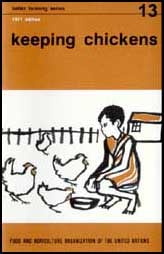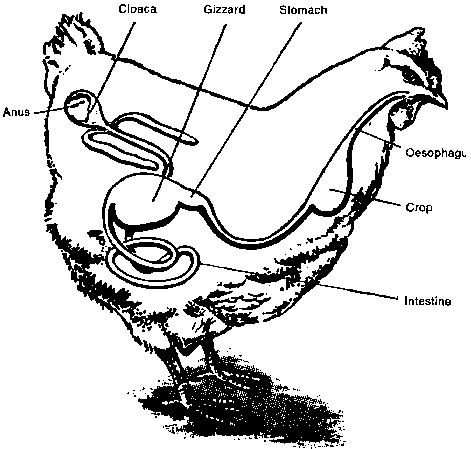
- (FAO - INADES, 1977, 48 p.)
How poultry make use of food and water[edit | edit source]
43. The digestive system of poultry begins with the beak and ends with the cloak and anus. A hen has no teeth to grind its feed; it swallows down its food at once.
44. The food swallowed passes into the oesophagus and then into three different organs:
- the crop where the food is moistened,
- the stomach where the food begins to be digested,
- the gizzard where the food is ground up.
45. You often see hens swallow little stones. These stones stay in the gizzard; when the feed arrives in the gizzard, it is ground up by the stones.
46. After this the feed is digested. The digested part goes into the blood and feeds the whole body. The remainder passes out through the cloaca; this is the excrement
Digestive system of a hen
Energy feeds[edit | edit source]
47. Poultry feed must contain above all energy feeds. Often the farmer can himself produce these feeds. The main energy feeds are:
- Maize, sorghum, millet, rice
You can give these in the form of grain or of meal. Poultry like maize; they can eat a lot of it without harm.
- Cassava
You can give it in the form of meal, or boiled. You must not give too much. In 10 kilogrammes of feed there should not be more than 2 kilogrammes of cassava.
- Rice bran
In 10 kilogrammes of feed, there should not be more than 1 kilogramme of rice bran.
- Palm- kemel oil cake
This is both an energy feed which can replace maize, and a body- building feed which can replace groundnut oil cake. In 10 kilogrammes of feed there should not be more than 1.5 kilogrammes of palm- kernel oil cake.
Body- building feeds: proteins[edit | edit source]
48. Body- building feeds are rich in proteins.
Poultry need proteins that come from animals and also proteins that come from plants.
For instance, if you give poultry 2 kilogrammes of feed containing proteins, there should be:
1.5 kilogrammes of vegetable proteins, 0.5 kilogramme of animal proteins.
49. Proteins that come from plants
Oil cake contains a lot of proteins.
Oil cake is the name for what is left when the oil has been taken from groundnuts, cotton, palm kernels, coconuts.
Groundnut oil cake
Poultry digest it well.
In 10 kilogrammes of feed, 1.5 kilogrammes can be groundnut oil cake.
Cotton oil cake
Poultry cannot digest a big amount of this.
In 10 kilogrammes of feed, not more than 0.5 kilogramme should be cotton oil cake.
Palm- kemel oil cake
This can take the place of maize and groundnut oil cake, but you should not give more than 1.5 kilogrammes of it in 10 kilogrammes of feed.
50. Proteins that come from animals
Boiled blood, meat meal, milk powder or fish meal. You should not give poultry too much protein.
It costs a lot and, if you give too much, it may make the poultry ill.
51. Energy feeds and body- building feeds are not well used by poultry unless you give at the same time:
- mineral salts, vitamins and clean water.
Mineral salts[edit | edit source]
52. In 10 kilogrammes of feed, there should be 200 grammes of mineral salts.
Bones, oyster and snail shells, and egg shells are rich in mineral salts.
If you do not give mineral salts, poultry cannot grow well; their bones will be small and badly formed.
Vitamins[edit | edit source]
53. You should mix vitamins in poultry feed if the birds are kept in a yard.
Otherwise the birds get vitamins by eating grass. Vitamins are given in very small quantities.
The farmer cannot produce them.
You have to buy them.
Vitamins can be bought in shops or from the animal husbandry centres.
Clean water[edit | edit source]
54. It is very important to give poultry plenty of clean water.
Poultry do not make good use of their food if they do not drink enough water.
One hen can drink a quarter of a litre of water a day.
For 20 hens, you need about 5 litres of water a day. If the weather is very hot, the birds will drink more. Each hen will drink about half a litre of water every day.
Put the water in fairly big drinking troughs so that several hens can drink at the same time.
Put the drinking troughs in the shade, near the feeding troughs.
Never let drinking troughs be empty. The water must always be clean. II It is dirty, it must be changed. Dirty water gives poultry a lot of diseases.
To make good use of feed poultry must drink a lot.
Special needs of chicks, laying hens, and table poultry[edit | edit source]
55. In domestic poultry keeping, the farmer produces and prepares most of the poultry feed himself.
In this way he does not spend much money; he uses up what is left over from the family's food and from his harvest.
But he must take care.
He has to give all the birds their complete feed, and this means different feed to birds of different ages.
56. From birth to 8 weeks
Chicks need above all body- building foods.
You should give them water and a feed containing, for instance: in every 10 kg of meal:
7 kg of crushed maize and/or other grains, 2 kg of groundnut oil cake,
1 kg of a mixture consisting of remains of meat, fish or blood, of oil or vegetables, of bones and crushed shells, of termites.
57. From 8 to 14 weeks
The feed should be more plentiful. There should be in every 10 kg of meal:
8 kg of crushed maize and/or other grains, 1.5 kg of groundnut oil cake,
0.5 kg of a mixture consisting of remains of meat, fish, blood, grass, termites, vegetables.
58. After 14 weeks
Give only maize grain or a mixture of maize with other grains.
Remember!
If the poultry are in a yard, you must also give them feeds that are rich in vitamins: grass vegetables; and rich in proteins: termites meat scraps fish scraps.
59. Laying hens
To make the shells of their eggs, laying hens need plenty of mineral salts.
To make the reserves in the egg, laying hens need plenty of proteins.
For instance, give in every 10 kg of feed:
8 kg of crushed grains (maize, sorghum), 1.5 kg of groundnut oil cake,
0.5 kg of a mixture consisting of meat or fish, boiled blood, grass and vegetables, and especially 300- 500 grammes of crushed bones, oyster or snail shells or egg shells.
60. During the first three months of life a bird eats about 5 kilogrammes of feed.
61. The food must be well mixed.
You must not make the mixture too long before giving it to the poultry, otherwise the food may go bad.
Feeding and drinking troughs and the drinking founts must always be very clean.
62. If a farmer buys poultry feed
- Either he buys all the feed
That is, a meal containing all the foods that poultry need to live and grow. He should not give any other food. This meal is costly. He must follow the seller's instructions and only give the necessary quantities.
- Or he buys only part of the feed - the concentrates
These are the kinds of meal that contain chiefly proteins, mineral salts and vitamins. If the farmer buys concentrates, he must also give crushed grain oil cake.
63. If you buy poultry feed, you have less work to do, but you may lose a lot of money.
Follow the advice of the animal husbandry centres.
